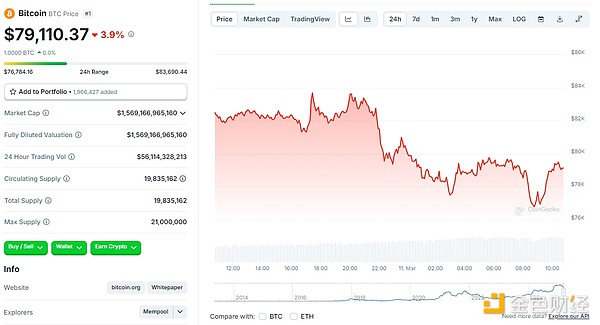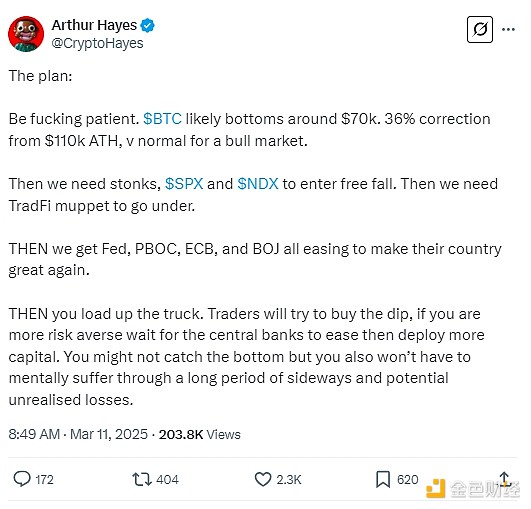Author: Tao Zhu, Jinse Finance
Since March 7, when former President Trump signed the Crypto Reserve Executive Order, causing BTC to fall below $90,000, the crypto market has continued this gloomy trend. This morning, BTC fell below the $80,000 mark. As of the time of writing, BTC is reported at $79,110.37, down 3.9% intraday.

So, what has caused BTC to decline? Has the current crypto bull market already ended?
I. The Decline in US Stocks Dragged Down the Crypto Market
The three major US stock indexes fell again, with the Dow Jones down 2.08%, the Nasdaq down 4%, and the S&P 500 down 2.7%. Large tech stocks fell across the board, with Tesla down over 15%, Nvidia down over 5%, Apple, Meta, Google down over 4%, and Microsoft down over 3%.
Crypto-related stocks in the US also saw continued declines, with across-the-board drops of over 10%, including: MicroStrategy (MSTR) down 13.56%; Coinbase (COIN) down 12.04%; Tesla (TSLA) down 12.17%; MARA Holdings (MARA) down 12.42%; Riot Platforms (RIOT) down 8.48%; Robinhood Markets, Inc. (1HOOD.MI) down 10.29%; Hut 8 Corp. (HUT) down 12.31%.
In addition, the Japanese and Korean stock markets followed the US stock decline and opened sharply lower, with the Nikkei 225 index down 1.1% at the open and the KOSPI index down 2.1%.
Citi has downgraded its rating on US stocks from overweight to neutral, while upgrading its rating on Chinese stocks to overweight, saying the "US exceptionalism" thesis has at least temporarily paused. A report by Citi strategists Dirk Willer et al. shows that the interruption of the "US exceptionalism" thesis is now more evident; the company has been overweight on US stocks since October 2023. Citi expects the growth momentum in the US to be lower than in other parts of the world, but the US stock market may outperform when the AI narrative regains dominance. Citi said that given the strength of China's tech industry, the government's support for the industry, and its low valuations, the Chinese stock market remains attractive even after the recent market rally; "DeepSeek proves that Chinese technology is at the forefront of Western technology, and even surpasses Western technology."
Currently, more and more Wall Street investors are disappointed with Tesla. Before Tesla's April delivery report and first-quarter earnings release, UBS and Redburn Atlantic reiterated their sell ratings on Tesla, citing weak Model Y delivery forecasts and a lack of growth catalysts recently. UBS lowered Tesla's target price by $24 to $225, while Redburn was more pessimistic, with a target price of $160. Redburn analyst Adrian Yanoshik wrote, "We expect sales to stagnate this year without new vehicle launches." "So far, the weak new car registration data may signal ongoing demand challenges. At the same time, we expect cash flow to be impacted by the ramp-up of the new Model Y variant that started deliveries in March. There is also the risk of potential tariffs on imports from Mexico, adding to the cost burden." Tesla has fallen more than 40% so far this year. If the trend does not reverse, the stock may fall for the eighth consecutive week, the longest (weekly) losing streak in the company's 15-year history.
Since Musk joined the Trump administration as the "Minister of DOGE", Tesla's stock price has been falling every week. DOGE is undertaking a broad and controversial initiative to reduce federal government spending and headcount. Tesla's market capitalization has now halved from its peak, equivalent to a loss of nearly $800 billion. Forbes data shows that Musk's net worth shrank by $22.8 billion on Monday, but he still leads the second-richest Bezos by over $100 billion.
The trading style in the current US stock market is undergoing a major change. Under the dual pressure of uncertainty in US trade policy and expectations of an economic recession, US stock investors are turning to defensive strategies: selling tech stocks and buying high-dividend yield stocks.
II. Tariff Threats Exacerbate Economic Concerns
The escalating tariff war tensions have raised concerns about the economy, offsetting the supportive statements on cryptocurrencies made by US President Trump last week. Due to concerns that Trump's tariffs and government layoffs will undermine US economic growth, risky assets like cryptocurrencies are under pressure. As investors seek safe havens, US stocks have declined and US Treasuries have risen. B2C2 head Nikolay Karpenko said: "While Trump's statement on the crypto currency strategic reserve initially boosted optimistic sentiment, the market has seen aggressive sell-offs as the macroeconomic situation has deteriorated, and this rebound has quickly dissipated."
The German magazine "Wirtschaftswoche" published an article by economist Desmond Lachman titled "Trump Could Trigger a New Euro Debt Crisis". The article argues that there are signs that the new US administration is targeting Europe, especially Germany, as the next target of its trade war. European policymakers should be prepared for a trade war. The US government has recently threatened to impose a 25% tariff on EU products imported into the US. However, the US government might want to consider the economic difficulties on the European continent: the German economy is in a slump, while Italy and France are struggling with relatively severe public debt problems. Perhaps by then, the US government will realize that its tariff policy - as part of the "America First" agenda - could trigger an economic recession in Europe and a debt crisis in the Eurozone.
Trump's tariff threats against Canada and Mexico will be fully reciprocated from April 2, and the tariffs may rise over time.
Moody's chief economist Mark Zandi believes the US economy may fall into stagflation. Recent data shows that US consumers and businesses are already concerned about the economic outlook and are reducing spending, which will lead to a significant slowdown in the economy, while the tariff effect will keep inflation high, so the US economy may fall into stagflation. If true, it will be the first time the US has experienced stagflation in 50 years. The Atlanta Fed's GDPNow model shows the US economy may have contracted 2.8% in the first quarter. If true, it will be the first contraction since the first quarter of 2022. Facing stagflation, the Fed may raise interest rates, just like former Fed Chairman Volcker did in the early 1980s, sacrificing the economy to curb inflation.
III. Trump's "Crypto Savvy" Aura Fades
Since Trump attended the Bitcoin conference last July and made a series of grandiose statements about the crypto industry, the market has been on a bullish run. Trump and his wife's issuance of Meme coins has had a negative impact on the market's credibility. The executive order on US crypto currency strategic reserves signed by Trump on the 7th was also within market expectations, so the market declined after the signing of the executive order. With the White House crypto summit, Trump did not introduce any concrete policies beneficial to the crypto market, and the market seems to have completely lost faith in Trump.
B2C2 head Nikolay Karpenko wrote that while Trump's statement on the crypto currency strategic reserve initially boosted optimistic sentiment, the wave of buying was quickly dissipated by the sell-offs triggered by the deteriorating macroeconomic environment. Solana, Cardano, and XRP plunged, which Trump had previously mentioned would be included in the crypto currency reserves, but were not mentioned in the final executive order.
Pepperstone strategist Michael Brown said in a report that the biggest problem facing the market is that Trump's policies "change like the wind". Trump's inconsistency on tariff issues has made it impossible for market participants to price in risks or accurately predict future policy paths. He said, "No one wants to touch US dollar assets now."
IV. Industry Perspectives:
BitMEX co-founder Arthur Hayes wrote in a post, "The plan is: be patient, don't rush."
Bitcoin may find a bottom around $70,000, a 36% pullback from the all-time high of $110,000 is a normal bull market correction.
Then we need to see the stock market, especially the SPX (S&P 500 index) and NDX (Nasdaq 100 index), plummet. After that, the "retail" investors in the traditional financial market will be in trouble.
Subsequently, the Federal Reserve (Fed), the People's Bank of China (PBOC), the European Central Bank (ECB) and the Bank of Japan (BOJ) will all adopt loose monetary policies in an attempt to revive their respective economies.
At that point, you can go all in. Traders will try to buy the dips, and if you are more risk-averse, you can wait until the central banks start easing before putting in more capital. You may not be able to time the bottom perfectly, but you won't be agonized by the prolonged sideways movement and potential unrealized losses.

YouHodler's market strategist Ruslan Lienkha stated that he claims the market is undergoing an adjustment and may evolve into a medium-term bearish trend. Lienkha: "Uncertainty is reaching a local peak, prompting traders to temporarily unwind positions. Typically, the bond market, especially US Treasuries, is a safe haven for investors during heightened expectations of economic recession."
When asked about the feasibility of Bit as a safe haven in the current market environment, Lienkha expressed skepticism. He said: "Currently, Bit is absolutely not a safe haven when the stock market is falling. Instead, its performance is more like a high-risk tech stock, with high volatility and large price swings, and while high volatility may lead to temporary divergences, Bit's medium-term performance is likely to be consistent with the overall stock market trend."
Research firm Kobeissi stated that one of the reasons for the economic recession is the DOGE's reduction in government spending, they believe that US government spending and employment growth have been 'driving' economic development, but DOGE's cost-cutting will have far-reaching implications, and it is currently unclear where a more reliable bottom for the BTC price may form.
Jeff Mei, Chief Operating Officer of the cryptocurrency exchange BTSE, said, "Bit is likely to fall to the $70,000 to $80,000 range in the coming weeks. Only when the trade war ends and the Fed resumes rate cuts will the major cryptocurrencies return to their previous highs."







